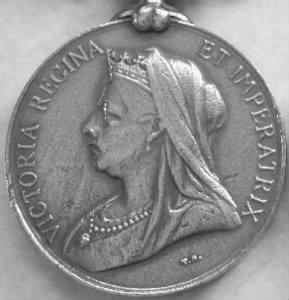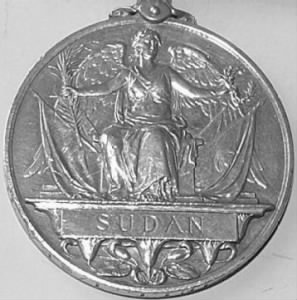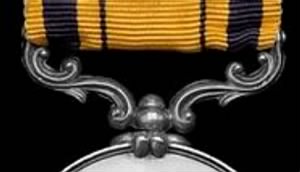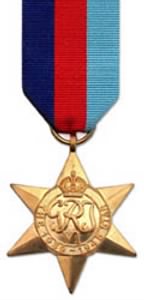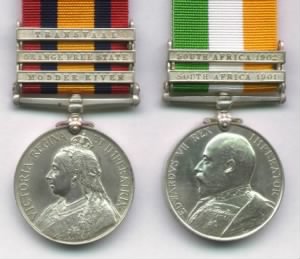Guide to British and Commonwealth Campaign Medals
The aim of this Campaign Medal Tutorial is to help aid you with your genealogy search and understanding of the British and Commonwealth Campaign Medals.
For over 200 years these Campaign Medal awards have marked the wars, battles, conflicts and campaigns fought by British and imperial forces across the world. It should be remembered that some of these campaign medals, especially the WWI medals, commemorate service in some of the bloodiest battles ever fought by British and Commonwealth forces in history.
With photographs and medals being one of the most common forms of memorabilia that a family may have of their military ancestors, the use of this tutorial may help identify details of their military career. One military photo or medal may look like another, though with a careful look one can reveal incredible details and information about a Serviceman’s past. A look above the left tunic pocket will show if a Serviceman is wearing any medals or ribbons for gallantry, campaigns or long service and a good look at a medal will help identify where service was carried out in a particular campaign or other similar geographic region. Some medals even have details like name, rank or ship engraved on them. Once these details are known you can check our records or medal rolls for that period.
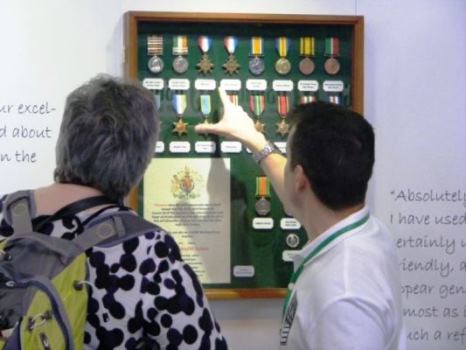
The idea of giving a member of the British Commonwealth a wearable reward goes back a long way in British military history. They were given out back in the old days of the English Civil Wars in limited numbers for loyal service and bravery, though not just for being in action at that time or place. Some historians say the first campaign medal to claim mass production to British Commonwealth troops was the medal for Cromwell’s victory at Dunbar back in 1651, as it was given to all ranks of the army engaged in this campaign. The Commons particularly wanted each soldier to receive a medal that bore Cromwell's likeness. Ultimately, officers received small gold medals while enlisted men were given a somewhat larger medal struck in silver. The medal was worn suspended from a chain around the neck.
It was the famous campaign and victory at the battle of Waterloo on June 18th 1815, which was fought near Brussels, Belgium that the British government decided to award a medal to every man present for the very first time in British History. Despite its name, it was awarded to those who took part in the Battles of Quatre Bras on the 16th June, battles of Ligny June 16th, 1815 and Waterloo on the 18th June 1815. Observing the soldier’s pride at the receipt of such decorations, and their desire to receive more such awards, Napoleon was quoted as saying "With a handful of ribbons I can conquer all of Europe." Many historians, collectors and experts consider the Waterloo Medal to be the first ‘official’ medal and considered the birth of the modern-day campaign medal, as it was authorized by the British Government to be awarded to all those present in a designated area at a designated time, regardless of their rank. Also, the Waterloo medal was the first to be issued in a standardised form for all recipients, officers did not receive a larger version, nor did they receive one in gold. Everyone got the same silver medal, worn with a distinctive ribbon. This was also the first British medal to all ranks that was officially named on the rim of the medal.
It became customary for governments to present a medal to all soldiers and officers involved in a campaign. These medals were often engraved with the names of the major battles the recipient had fought in during the campaign. The main disadvantages of this system were that new medals had to be created for each campaign or war, and that it was impossible to tell at a glance if the recipient was only a participant in the campaign overall, or if he had been involved in one or several major actions.
In the Victorian age of mid-1800 the British armed forces were in action again with its Navy and Army fighting campaigns in every corner of the British Empire. Campaign medals were made for every conflict and campaign along with bars/clasp issued for minor operations or for specific battle engagements. The first medal bars/clasps were given either for participation in a whole campaign or just for some particularly important action.
The Sutlej Medal of 1845-46 was the earliest to identify a recipient’s participation in separate battles in a distinctive way with clasps. The first battle the recipient participated in would be engraved on the medal itself. If the recipient had participated in multiple engagements, silver bars bearing the name of each additional battle were attached to the medal's ribbon. This method of notation evolved again on the Punjab Campaign medal, where the standard medal was awarded to all personnel that had served during the campaign, with bars produced for the three major battles; the Battle of Chillianwala, the Siege of Multan, and the Battle of Gujarat. Thereafter, the idea of commemorating participation in a particular battle or operation by the award of clasps became the norm: medals for most of the campaigns after 1850 carried battle clasps and the use of these clasps is still used on today’s British campaign medals.
After World War One, campaign medals were issued on a grand scale never seen before. Millions of servicemen who served in the British military during the War were entitled to at least one medal for being there. Nearly five million men passed through the British Army from 1914-18, though men who were stationed in the UK were not entitled to a medal, yet any who served abroad were. Also, there was a grand number of civilian, nursing and Para-military personnel that where entitled to a medal.
It was intended that older medal traditions be followed and award the medals in silver with battle or operation clasps. The Army had many proposals, these totalled 79 and the Navy 68, though it was deemed to be complicated to work out who had earned what clasp and also to be too costly, so this idea was abandoned. Instead it was decided that general War medals would be awarded and that all eligible personnel regardless of service branch or theatre of war would be given the same medal. In the end, only seven different campaign medals were issued for service in World War One, these being the bronze 1914 (Mons Star) and 1914-18 Star, the Silver British War Medal, the gilt-washed Victory medal, the bronze Mercantile Marine War Medal and the Territorial Force War Medal. The only clasp awarded in these campaign medals of World War One was one dated ‘5th AUG.-22nd NOV. 1914’ that was to be attached onto the ribbon of the 1914 Star and awarded to those who had operated within range of enemy mobile artillery during the above period.
The British government had the same problem with the Second World War of 1939-45, with millions of men and women in all branches of the service and in all Commonwealth, countries fighting many campaigns over the six years of this global conflict. Again, the idea of very specific battle clasps or awards was abounded like in 1918 in favour of ‘theatre’ awards. In the end eleven campaign medal awards were issued, these being the War Medal, Defence Medal, 1939-45 Star, Italy Star, Africa Star, France and Germany Star, Burma Star, Pacific Star, Atlantic Star, Air Crew Europe Star and the very latest to be awarded the Arctic Star.
The practice of issuing campaign medals has continued ever since, with medals still being awarded for service in Iraq and Afghanistan. The reasons for awarding them to a recipient might have changed over time, as they are generally awarded for participation in a military action in which:
- Service takes place in a clearly defined, broad area of operation.
- Large-scale military operations are involved.
- There are active, opposing, and hostile forces.
- The risk of death or injury is clear and present.
- Combat operations take place over a sustained period of time.
- There is a specific and limited period of eligibility.
- Deployment involves extended family separation and personal inconvenience.
- Eligibility terminates with conclusion of major hostilities.
Order of British Campaign Medals.
Below is a list of all the British campaign medals/ribbons that have been awarded to eligible personnel of the British Armed Forces and Commonwealth, including the eligibility period. These campaign medals include all Allied Forces and civilians who took part in a military Campaign or for service in time of war.
19th Century Campaign Medals

March 1799 – 8th May 1799.

1808- 1814.

16th Jun – 18th Jun 1815.

21st Jul 1839 – 23rd Jul 1839.

Candahar, Ghuznee, Cabul Medal (1842).
1839 – 1842.

1839 - 1842

Medal for the Defence of Kelat-L-Ghilzie (1842).
1839 – 1842.

5th July 1840 – 29th Aug 1842.

1842 – 1843.

29th Dec 1843.

7th Sept 1845 – 14th Mar 1849.

Naval General Service Medal (1847).
1793 – 1840.

Military General Service Medal (1847).
1793 – 1814.

7th Sep 1848 – 14th Mar 1849.

1803 – 1826.

India General Service Medal (1854).
1852 – 1895.

1834 – 1835.

1854 – 1856.

1854 – 1855.

1857 – 1858

Second China War Medal (1861).
1856 – 1860

1845 – 1866.

4th Oct 1867 – 19th

(1866 – 70)

%20ribbon.png)
1877 – 1879

1878 – 1880.

Kabul to Kandahar Star (1880).


British South Africa Company Medal
(1890 – 97).

East and West Africa Medal (1892).
13th Nov 1887 – 8th May 1900.

1891 – 1894.

India General Service Medal (1895).
3rd Mar 1895 – 10th Mar 1902.



East and Central Africa Medal (1899).
20th Jul 1897 – 2nd May 1899.

Queen’s South Africa Medal (1902).
1899 – 1902.

Queen’s Mediterranean Medal (1899).
(for South Africa)
20th Century Campaign Medals
Pre World War One
King's South Africa Medal (KSA)
1st Jan 1902 – 1st Jun 1902
Africa General Service Medal (1902 - 1956)
13th Dec 1903 – 23rd Sept 1904
India General Service Medal (1909)
1908 – 1935.
World War One Campaign Medals.
5th Aug 1914 – 22nd Nov 1914
5th Aug 1914 – 31st Dec 1915
5th Aug 1914 – 11th Nov 1918
5th Aug 1914 – 11th Nov 1918 & 11th November 1918 – 30th Nov 1919
4th Aug 1914 – 11th Nov 1918
4th Aug 1914 – 11th Nov 1918
World War Two Campaign Medals.
3rd Sept 1939 – 2nd Sept 1945
3rd Sept 1939 – 8th May 1945
3rd Sept 1939 – 8th May 1945
3rd Sept 1939 – 5th Jun 1944
10th Jun 1940 – 12th May 1943
8th Dec 1941 – 2nd Sept 1945
11th Dec 1941 – 2nd Sep 1945
11th Jun 1943 – 8th May 1945
6th Jun 1944 – 8th May 1945
3rd Sept 1939 – 2nd Sept 1945
3rd Sept 1939 – 2nd Sept 1945
3rd Sept 1939 – 2nd Sept 1945
Canadian Volunteer Service Medal
3rd Sept 1939 – 1st Mar 1947
6th Sept 1939 – 2nd Sept 1945
Australia Service Medal (1939-45)
3rd Sept 1939 – 2nd Sept 1945
3rd Sept 1939 – 2nd Sept 1945
South African Medal for War Service
6th Sept 1939 – 15th Feb 1946
South Rhodesia Medal for War Service
3rd Sept 1939 – 2nd Sept 1945
Newfoundland Volunteer War Service Medal
3rd Sept 1939 – 2nd Sept 1945
Post World War Campaign Medals
1st Jul 1950 – 27th Jul 1953
General Service Medal (1962 GSM)
24th Dec 1962 – 31st Jul 2007
1st Dec 1979 – 20th Mar 1980
2nd Apr 1982 – 12th Jul 1982
2nd Aug 1990 – 7th Mar 1991
Accumulated Campaign Service Medal
(1994 – 2011)
21st Century Campaign Medals
Operational Service Medal for Sierra Leone (2000)
5th May 2000 – 31st July 2002
Operational Service Medal Afghanistan (2002)
11th Sept 2001 - 2021
Operational Service Medal for the Democratic Republic of Congo
14th Jun 2003 – 10th Sept 2003
20th Jun 2003 – 2011
Iraq Reconstruction Service Medal (2004)
19th Mar 2003 – 1 October 2013
Civilian Service Medal (Afghanistan) (2011)
19th Nov 2001 – present
Accumulated Campaign Service Medal (2011)
Meanings of Different Parts Of Military Medals
Obverse: The side of the medal that usually bears the Sovereign’s head. There are however a few medals which bear other heads, such as those awarded for Waterloo, the Sarawak Long Service Medal. Also, early naval and military Long Service Medals bore no head. In such cases the side with the design is usually considered to be the obverse.
(medal obverse)
Reverse: The opposite side to obverse. This generally bears the design or inscription, and sometimes both.
(medal reverse)
Coinage Head: This is the Sovereign’s head as used on coins. (see Obverse for picture)
Classic Head: See above. (Medal reverse)
Rim: The raised part of the medal edge which prevents damage to the piece when it is laid flat.
Edge: The outside circumference of the medal which usually bears the recipient’s name, rank, reg etc.
Impressed: This means that the recipient’s details on the edge have been impressed.
Indented: This means that the recipient’s details on the edge have been indented.
Embossed: This means that the wording or matter referred to is raised, such as the recipient’s name on the reverse of the Abyssinian medals issued to Europeans.
Engraved: This means that the inscription of such matter as is found on the edge, such as the particulars of the recipient, is engraved.
Piece: This is the lower circular, or octagonal part of the medal.
Exergue: The space below the horizontal line on the reverse.
Claw: This is the fitting on the medal which joins it to the suspender.
Suspender: This is the fitting which takes the ribbon and joins on to the claw either rigidly, or in such a way as to enable the piece to be swivelled. It can be found in the form of either plain, straight and ornate. Some medals are suspended by a ring connecting the ribbon directly to the piece.
(medal claw)
Ribbon: Medals are worn suspended from their own specific ribbons. These were first made of silk but cotton was increasingly used as the nineteenth century developed. Their own colours often have a symbolic significance: the equal stripes of the ‘1939 to 1945 Star,’ for example, are dark blue to represent the service of the Royal and Merchant Navies, red, to represent that of the Armies and light blue to represent that of Air Forces.
(medal ribbon 1939- 1945 star)
Bars: They are single-faced metal bars carried on a ribbon attached to the medal, indicating the recipient’s service in a particular campaign or battle. The bars carry side flanges to enable them to be attached to the medal and riveted to each other, so that new ones can be attached as earned. Usually the first earned Clasp is closest to the medal, so that the latest earned should be at the top, although they can be found in the wrong order. For example, the Queen’s South Africa Medal had twenty-six bars issued. The bars come in different patterns, plain rectangular, thin, or wide, fishtail as used on the China, 1860, and Indian Mutiny Medals. In some cases, like the 1914 Star the bar was affixed to the ribbon.
(medal with bars)
Clasp: This is another term used to quote the bars awarded of the recipients (as above, see picture).
Rosettes: These are small circular roses placed on the ribbon when it is worn alone, this rosette denotes award of the clasp.
(Medal ribbon with attached Rosette)
Oak Leaf: Soldiers of the British Empire or the Commonwealth of Nations who are mentioned in dispatches but do not receive a medal for their action, are nonetheless entitled to receive a certificate and wear a decoration. Soldiers can be mentioned multiple times. Award of a Mention ranked below M.C. or M.M. and could be for gallantry in action or for a wide range of services on and off the battlefield.
(Oak leaf - Mentioned In Despatches)
Ears: These are the fitting at both ends of the bars to enable subsequent bars to be fitted.
Group: This means a group of medals awarded to one individual.













































